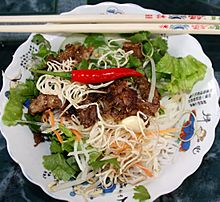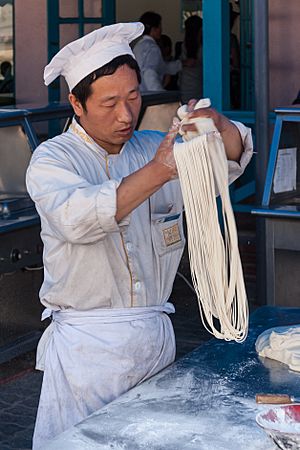Noodle facts for kids
| Type | Noodle |
|---|---|
| Main ingredients | Unleavened dough |
| Variations | Numerous |
Noodles are a very popular food eaten in many countries around the world. They are made from dough that has not been leavened (meaning no yeast or baking powder). This dough is stretched, pushed out, or rolled flat. Then, it is cut into many different shapes.
While long, thin strips are common, noodles can also be waves, spirals, tubes, or shells. They can even be folded over or cut into other fun shapes. Noodles are usually cooked in boiling water. Sometimes, a little cooking oil or salt is added. They can also be pan-fried or deep-fried. Noodles are often served with a tasty sauce or in a soup. You can keep them in the fridge for a short time. Or, they can be dried and stored for a long time. The word "noodle" comes from the German word Nudel.
Contents
History of Noodles

Noodles first came from China. The oldest written record of noodles is from a book written during the Eastern Han period (25–220 CE). Noodles were often made from wheat dough. They became a main food for people during the Han dynasty (206 BCE – 220 CE).
In 2005, scientists found something amazing in China. They reported finding a 4,000-year-old bowl of noodles at an archaeological site called Lajia. These ancient noodles looked like lamian. Lamian are a type of Chinese noodle made by pulling and stretching the dough by hand.
Noodles in Asia

Wheat noodles like udon in Japan came from a Chinese recipe. A Buddhist monk brought the recipe as early as the 9th century. Reshteh noodles were eaten in Persia by the 13th century.
New types of noodles kept appearing. For example, noodles made from buckwheat (called naengmyeon) were created in Korea during the Joseon Dynasty (1392–1897). Ramen noodles, which are based on Chinese noodles, became very popular in Japan by 1900.
Noodles in Europe and the Near East
In the 1st century BCE, a writer named Horace wrote about fried sheets of dough called lagana. These were not exactly like modern pasta, but they shared some basic ingredients. In the 2nd century CE, a Greek doctor named Galen talked about itrion. This referred to any mix of flour and water.
Later, Arabs started using noodles for long journeys around the 5th century. This is the first time we hear about dry pasta. In the 9th century, an Arab doctor described itriyya. This was a string-like noodle made from semolina and dried before cooking. In 1154, Muhammad al-Idrisi wrote that itriyya was made and sent out from Norman Sicily.
The first clear information about pasta products in Italy comes from the 13th or 14th centuries. Pasta has developed into many different shapes. These shapes often depend on the region where they are made. Since the 1900s, pasta has become a main food in North America and other places.
In the area that is now Germany, a noodle called Spätzle was mentioned in writings from 1725. However, pictures from the medieval times suggest this noodle existed even earlier.
Zacierki is a type of noodle found in Polish cuisine.
Types of Noodles by Main Ingredient
Wheat Noodles
- Bakmi: Yellow wheat noodles from Indonesia and China, often with egg and meat.
- Chūka men (中華麺): Japanese name for "Chinese noodles," used for ramen and yakisoba.
- Kesme: Flat, yellow or reddish-brown wheat noodles from Central Asia.
- Kalguksu (칼국수): Korean noodles cut with a knife.
- Lamian (拉麵): Chinese noodles pulled by hand.
- Lasagne: Flat sheets of Italian pasta, usually baked in layers.
- Mee pok (麪薄): Flat, yellow Chinese noodles popular in Southeast Asia.
- Reshte: Flat, very pale noodles from Central Asia, used in Persian and Afghani cooking.
- Spätzle: Egg noodles found in Germany and the Alps.
- Sōmen (そうめん): Thin Japanese wheat noodles, often coated with vegetable oil.
- Thukpa (Tibetan: ཐུག་པ་, Wylie: thug pa): Flat Tibetan noodles.
- Udon (うどん): Thicker Japanese wheat noodles.
- Kishimen (きしめん): Flat Japanese wheat noodles.
Rice Noodles
- Bánh phở: Vietnamese name for Chinese rice noodles called ho fun.
- Flat or thick rice noodles: Also known as hé fěn or ho fun (河粉), kway teow or sen yai (เส้นใหญ่).
- Rice vermicelli: Thin rice noodles, also called mǐfěn (米粉) or bee hoon.
- Idiyappam: An Indian rice noodle.
- mixian and migan: Noodles from southwest China.
- Khanom chin: A fermented rice noodle used in Thai cuisine.
| style="text-align: left; vertical-align: top; " |
Buckwheat Noodles
- Makguksu (막국수): A special noodle from Gangwon Province in South Korea.
- Memil naengmyeon (메밀 냉면): Korean noodles made from buckwheat, a bit chewy.
- Soba (蕎麦): Japanese buckwheat noodles.
- Pizzoccheri: Italian buckwheat tagliatelle from Valtellina, often served with cheese sauce.
Other Noodles
- Acorn noodles: Also called dotori guksu (도토리국수) in Korean. They are made from acorn meal, wheat flour, and salt.
- Olchaeng-chi guksu: Meaning tadpole noodles. These are made from corn soup pushed through a noodle maker into cold water. They are named for their shape. These Korean noodles are mostly eaten in Gangwon-do.
- Cellophane noodles: Made from mung bean starch. They can also be made from potato starch or other similar starches.
- Chilk naengmyeon (칡 냉면): Korean noodles made from kudzu root starch. They are chewy and see-through.
- Shirataki noodles (しらたき): Japanese noodles made from konjac plant.
- Kelp noodles: Made from seaweed.
Types of Noodle Dishes
- Baked noodles: Noodles are cooked, drained, and then mixed with other ingredients. This mix is then baked. Good examples are lasagne and many casseroles.
- Basic noodles: These are cooked in water or broth and then drained. You can add other foods to them, or add the noodles to other dishes. They can also be served plain with a dipping sauce or oil. Noodles are usually soft and soak up flavors well.
- Chilled noodles: Noodles that are served cold, sometimes in a salad. Examples include Thai glass noodle salad and cold udon.
- Fried noodles: Dishes where noodles are stir-fried with different meats, seafood, vegetables, or dairy products. Some common examples are chow mein, lo mein, mie goreng, yakisoba, and pad thai.
- Noodle soup: Noodles served in a flavorful broth. Famous examples include phở, beef noodle soup, ramen, and laksa.
Images for kids
See also
 In Spanish: Fideo para niños
In Spanish: Fideo para niños








